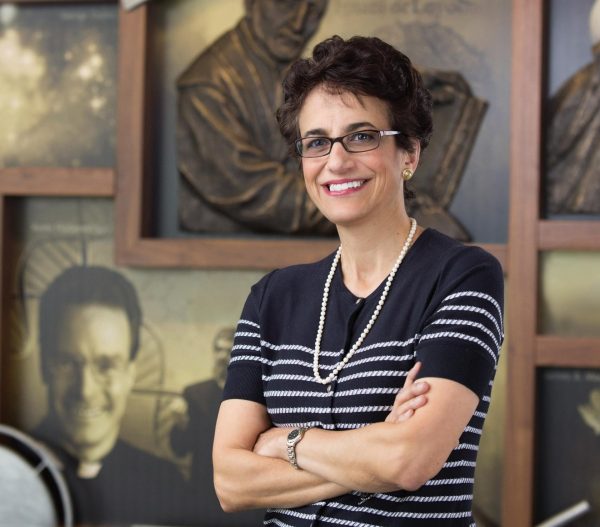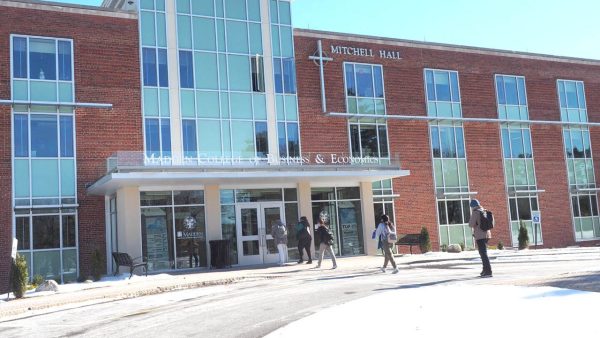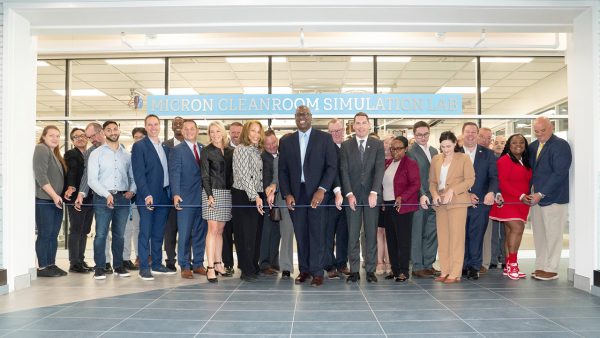Get our email updates
Stay up-to-date on the companies, people and issues that impact businesses in Syracuse, Central New York and beyond.
What's New
Upcoming Events
CNYBJ Job Board

Le Moyne extends LeMura’s contract as president through June 2028
SYRACUSE, N.Y. — Linda LeMura, president of Le Moyne College in Syracuse, will continue leading the school through June 30, 2028. The Le Moyne College

Golisano Institute for Business & Entrepreneurship to open location in Buffalo
BUFFALO, N.Y. — The Golisano Institute for Business & Entrepreneurship is expanding its footprint in Western New York and opening a location in Buffalo. The new campus center will be located in the former office building of The Buffalo News on Washington Street and is expected to welcome its first students in the fall of
Get Instant Access to This Article
Become a Central New York Business Journal subscriber and get immediate access to all of our subscriber-only content and much more.
- Critical Central New York business news and analysis updated daily.
- Immediate access to all subscriber-only content on our website.
- Get a year’s worth of the Print Edition of The Central New York Business Journal.
- Special Feature Publications such as the Book of Lists and Revitalize Greater Binghamton, Mohawk Valley, and Syracuse Magazines
Click here to purchase a paywall bypass link for this article.
BUFFALO, N.Y. — The Golisano Institute for Business & Entrepreneurship is expanding its footprint in Western New York and opening a location in Buffalo.
The new campus center will be located in the former office building of The Buffalo News on Washington Street and is expected to welcome its first students in the fall of 2026.
Ian Mortimer, president of Golisano Institute for Business & Entrepreneurship, shared the announcement Thursday at the future campus center, emphasizing that the Buffalo location will deliver the same accelerated, non-traditional business education offered in Rochester — a model made possible by the Golisano Institute’s founder, entrepreneur, and philanthropist Tom Golisano.
“At Golisano Institute, we remain committed to providing a highly focused set of business learning and experiences that students complete in just two years,” said Mortimer. “With our first class graduating this past August, we have evidence that the Institute’s approach yields business career success, and we’re excited to bring that same opportunity to students in Buffalo and across Western New York.”
The Buffalo campus center will join the Institute’s Rochester–area flagship location in Brighton, which opened in 2023. Its two-year professional certificate program in business & entrepreneurship is designed to equip students of all ages with practical business skills and real-world experience, at a tuition cost of $8,900 per year.
During the program, students will gain “broader exposure” to the business world through a variety of experiences, including multiple internships and through the Golisano Institute’s weekly “Speaking from Experience” series, which propels students to engage directly with some of today’s most successful business and entrepreneurial leaders.
“I founded the Institute to make quality business education more accessible and grounded in what truly matters for success,” Golisano said. “Over the last two years, it’s been inspiring to watch our students in Rochester grow and gain economic opportunities. Buffalo is a city with a strong entrepreneurial spirit, and by expanding here, we’re not only opening doors for more students but also helping regional businesses gain the skilled, motivated talent they need to thrive. If we further the business energy and opportunities across the entirety of Western New York, students and businesses will grow economic wealth.”

Mayor proposes nearly $2 million for three Binghamton housing projects
BINGHAMTON, N.Y. — Binghamton Mayor Jared Kraham on Oct. 16 announced plans to allocate $1.9 million to support three housing projects in the city of

Community Bank grows downtown Syracuse presence with new South Side branch
SYRACUSE — Community Bank N.A. continued its expansion in Syracuse with the recent formal opening of a new branch office on the city’s South Side, an area currently undergoing revitalization. The bank, which is part of DeWitt–based Community Financial System, Inc. (NYSE: CBU), hosted an Oct. 11 ribbon-cutting event and community celebration, in partnership with
Get Instant Access to This Article
Become a Central New York Business Journal subscriber and get immediate access to all of our subscriber-only content and much more.
- Critical Central New York business news and analysis updated daily.
- Immediate access to all subscriber-only content on our website.
- Get a year’s worth of the Print Edition of The Central New York Business Journal.
- Special Feature Publications such as the Book of Lists and Revitalize Greater Binghamton, Mohawk Valley, and Syracuse Magazines
Click here to purchase a paywall bypass link for this article.
SYRACUSE — Community Bank N.A. continued its expansion in Syracuse with the recent formal opening of a new branch office on the city’s South Side, an area currently undergoing revitalization.
The bank, which is part of DeWitt–based Community Financial System, Inc. (NYSE: CBU), hosted an Oct. 11 ribbon-cutting event and community celebration, in partnership with Visa, to mark the opening of the new branch at 4141 S. Salina St.
To commemorate the grand opening, the bank said it invited its new neighbors to a special community celebration at the branch, featuring family-friendly activities, food trucks, and giveaways. The highlight of the event was a special appearance by Syracuse University football head coach Fran Brown, who helped cut the ribbon on the new full-service location and spent time with guests during a meet-and-greet, the bank said in an announcement. Through an NIL collaboration with Syracuse University Football established last year, Community Bank supported players through a teamwide financial literacy program, helping players establish bank accounts and build strategic money management habits.
The remodeled South Salina Street branch is the latest new office Community Bank has opened across Onondaga County under its strategic growth plan and underscores its long-term investment in expanding its presence and service in the region, the announcement stated.
Community Bank has opened two other new branches in the Syracuse area in the last year — one in downtown Syracuse in Hanover Square last October, and another branch in the Liverpool area (town of Clay) this past April. The bank says it will continue to strengthen its presence in the market, investing $42 million in its planned new Syracuse corporate headquarters and opening another branch in Clay in 2026 — bringing its branch count to six across Onondaga County.
South Salina Street branch details
“Today marks a meaningful milestone for Community Bank as we continue to grow our presence in downtown Syracuse and deepen our commitment to the communities we serve across the Northeast,” Community Bank Central New York Regional President Lindsay Weichert said in the bank’s announcement. “Our South Salina branch represents more than growth — it’s a testament to the resilience, opportunity and bright future of this community and we’re proud to be a part of this next chapter, supporting broader revitalization efforts and access to financial guidance and services to the people and businesses on Syracuse’s South Side.”
Among its modern design features, the South Salina Street branch offers Community Bank’s full suite of consumer, business, and government banking products including access to Greenlight Financial Technology Inc. and loan incentives for new customers.
The branch office and drive-thru hours are Monday through Thursday 9 a.m.-4 p.m., and Friday 9 a.m.-5 p.m. Online-banking services are available at cbna.com.

Oechsner Farms honored by state for conservation efforts
NEWFIELD — Oechsner Farms, located in Newfield in Tompkins County, has been awarded the 2025 New York Agricultural Environmental Management (AEM)-Leopold Conservation Award. The honor recognizes a farm and its nominating soil and water conservation district (SWCD) who have “gone above and beyond” in the management of soil health, water quality, and wildlife habitat on
Get Instant Access to This Article
Become a Central New York Business Journal subscriber and get immediate access to all of our subscriber-only content and much more.
- Critical Central New York business news and analysis updated daily.
- Immediate access to all subscriber-only content on our website.
- Get a year’s worth of the Print Edition of The Central New York Business Journal.
- Special Feature Publications such as the Book of Lists and Revitalize Greater Binghamton, Mohawk Valley, and Syracuse Magazines
Click here to purchase a paywall bypass link for this article.
NEWFIELD — Oechsner Farms, located in Newfield in Tompkins County, has been awarded the 2025 New York Agricultural Environmental Management (AEM)-Leopold Conservation Award.
The honor recognizes a farm and its nominating soil and water conservation district (SWCD) who have “gone above and beyond” in the management of soil health, water quality, and wildlife habitat on working land, according to the Sept. 12 announcement from the New York State Department of Agriculture and Markets.
Richard Ball, New York State agriculture commissioner, and partners from the Sand County Foundation visited Oechsner Farms to honor Thor Oechsner and his spouse, Rachel Lodder, who own and operate the farm, during a special ceremony.
Oechsner Farms is a regenerative organic certified grain farm operated by Thor Oechsner and his team. Together, they farm more than 1,200 acres of hard red spring and winter wheats, hulless oats, common and tartary buckwheat, polenta type corn, rye, einkorn, grass/legume hay, and red clover as their main rotational crops, primarily for organic food-grade and craft-malt beverage markets.
Prioritizing soil health has been a key ingredient in the farm’s success. As an active participant in New York’s Agricultural Environmental Management program, Oechsner Farms is a “conservation showcase in Tompkins County,” the department said.
“Farms like Oechsner Farms play a central role in feeding our families while also protecting soil and water quality in communities across New York State,” Richard Ball, New York State agriculture commissioner, said in the announcement. “On behalf of the Department and New York State, I congratulate the Oechsner family and their team on receiving the esteemed AEM-Leopold Conservation Award and the Tompkins County Soil and Water Conservation District for their work with farms in the county and Finger Lakes Region. Their innovation and pride in their work, as well as their commitment to biodiversity and preserving wildlife habitats, are exemplary of the AEM-Leopold mission and an inspiration to other farms following in their footsteps.”
The state made the announcement of ahead of Climate Week, the New York State Department of Agriculture and Markets said.
Sand County Foundation and national sponsor American Farmland Trust will present Leopold Conservation Awards to landowners in 28 states this year. Given in honor of renowned conservationist Aldo Leopold, the award recognizes farmers who inspire others with their dedication to environmental improvement, per the state’s announcement.
In his influential 1949 book, A Sand County Almanac, Leopold advocated for “a land ethic,” an ethical relationship between people and the land they own and manage.
New York’s longstanding Agricultural Environmental Management (AEM) Award paired with the Leopold Conservation Award program in 2020. In partnership with the New York State Department of Agriculture and Markets, the AEM-Leopold Conservation Award honors a farm and its nominating SWCD for their efforts to promote and protect the environment through the preservation of soil and water quality while helping to ensure farm viability for future generations.
Earlier this year, New York State SWCDs were encouraged to identify and nominate the best examples of conservation success in their district. Applications were reviewed by an independent panel of agricultural and conservation leaders from New York.

Le Moyne’s Madden Corporate Partnership Program is underway
SYRACUSE — The Madden Corporate Partnership Program (MCPP) is a new initiative at Le Moyne College through the school’s Madden College of Business and Economics. The college has selected M&T Bank (NYSE: MTB) as its first corporate partner under the MCPP. Under the program, eligible employees of M&T Bank (NYSE: MTB) who enroll in selected
Get Instant Access to This Article
Become a Central New York Business Journal subscriber and get immediate access to all of our subscriber-only content and much more.
- Critical Central New York business news and analysis updated daily.
- Immediate access to all subscriber-only content on our website.
- Get a year’s worth of the Print Edition of The Central New York Business Journal.
- Special Feature Publications such as the Book of Lists and Revitalize Greater Binghamton, Mohawk Valley, and Syracuse Magazines
Click here to purchase a paywall bypass link for this article.
SYRACUSE — The Madden Corporate Partnership Program (MCPP) is a new initiative at Le Moyne College through the school’s Madden College of Business and Economics.
The college has selected M&T Bank (NYSE: MTB) as its first corporate partner under the MCPP. Under the program, eligible employees of M&T Bank (NYSE: MTB) who enroll in selected graduate programs in the Madden College of Business and Economics will receive a 20 percent reduction in tuition.
The programs include the Master of Business Administration (MBA) and Master of Science in Information Systems (MSIS) degrees. The tuition reduction would start with the spring 2026 semester.
M&T Bank has nearly 400 employees working in the Central New York region and the bank sees value in opening a pathway to a Le Moyne degree for those who are interested.
“Recognizing their strong presence in this region, we approached Le Moyne about becoming a corporate partner for these graduate programs in the Madden College of Business and Economics,” Steve Gorczynski, M&T Bank regional president for Central New York, said in the Le Moyne announcement. “As a 1990 graduate, I know firsthand the value of a Le Moyne education and the distinction that comes from earning a degree from the College.”
Le Moyne has more than 30 graduates who have had careers with M&T Bank, the school noted.
Qualifying, maintaining membership
To qualify and maintain membership in MCPP, businesses must have more than 10 full-time employees and “show a demonstrated commitment” to Le Moyne College. The school has no minimum number of employees required to enroll to receive the reduced tuition rate.
Companies must also “hold a clear commitment” to the Central New York region and its future development.
They must also “regularly promote the partnership” with Le Moyne College to employees. Examples can include hosting Le Moyne faculty and staff at the organization to meet with prospective students, emailing program materials to employees, and/or scheduling virtual information sessions for employees to express interest and learn more about the partnership.
Companies must also “serve as points of contact” for the Madden College of Business and Economics regarding “cutting-edge and future-forward” curricular matters.
Applicants who are admitted to the MBA or MSIS program at Le Moyne College will be automatically screened for their eligibility during the admission process. Should applicants work at an official Madden corporate partner, they will be notified in their admission letter that this award will be applied to their bill.
Students will be required to supply a simple employment-verification form each term to receive the reduced tuition rate. Employment must be maintained at an approved Madden corporate partner to continue receiving the tuition reduction, Le Moyne said.
An application to become a Madden Corporate Partner is available at this link: https://connect.lemoyne.edu/register/?id=769c62e8-ff4a-47ec-95bd-b1407d9b1baf.
The application should be completed by a human-resources representative or appropriate executive-level leader in the organization, Le Moyne noted.

Wedding venue MKJ Farm has a new owner, rebrands as Marshall Mountain Resort
DEANSBORO, N.Y. — MKJ Farm, an event venue in Oneida County that’s been hosting weddings, is under new ownership and is getting a new name. MKJ Farm, which at one time operated as a dairy farm, is located at 6844 W. Hughes Road in Deansboro, which is southwest of Clinton. The owners are rebranding the
Get Instant Access to This Article
Become a Central New York Business Journal subscriber and get immediate access to all of our subscriber-only content and much more.
- Critical Central New York business news and analysis updated daily.
- Immediate access to all subscriber-only content on our website.
- Get a year’s worth of the Print Edition of The Central New York Business Journal.
- Special Feature Publications such as the Book of Lists and Revitalize Greater Binghamton, Mohawk Valley, and Syracuse Magazines
Click here to purchase a paywall bypass link for this article.
DEANSBORO, N.Y. — MKJ Farm, an event venue in Oneida County that’s been hosting weddings, is under new ownership and is getting a new name.
MKJ Farm, which at one time operated as a dairy farm, is located at 6844 W. Hughes Road in Deansboro, which is southwest of Clinton.
The owners are rebranding the property to Marshall Mountain Resort, says co-owner Dan Williams, who spoke with CNYBJ on Oct. 14. Williams explained the origin of the new name, saying that Deansboro is part of the Oneida County town of Marshall and the property has a 500-foot vertical drop from top to bottom.
MKJ Farm is planning a Fall Festival and grand reopening on Oct. 25, which will include an announcement about the name change.
Weddings will remain a focus for the venue, but the rebrand reflects plans to expand into hosting corporate retreats and picnics, college events, health and wellness summits, outdoor adventures, and other events. Besides weddings, MKJ Farm has also hosted concerts by Willie Nelson, the Charlie Daniels Band, and Lynyrd Skynyrd, Williams notes.
Besides co-owning Marshall Mountain Resort, Williams is also owner of Williams Fence and Excavating and Blueberry Brook Farm Resort, both located in Deansboro. Corey Glazier, VP and field operations manager of Williams Fence and Excavating, also co-owns MKJ Farm.
Williams and Glazier bought MKJ Farm from John (Jack) Buschmann in July of this year, as Buschmann was getting ready to retire, Williams says. He declined to disclose the acquisition price.
“We have been using the property for the last 11 years … with the Daniel Barden Mudfest. We’ve made a lot of improvements. We built this five-mile course and put up [fencing],” says Williams. “It just made good business sense.”
They’ve hosted the Daniel Barden Mudfest charity event at MKJ Farm for more than a decade. The event is named after one of the young victims of the Sandy Hook, Connecticut school shooting in December 2012. Williams tells CNYBJ that his niece lives in Sandy Hook, was a friend and neighbor of Barden, and was in the school that day. Williams attended the funeral for Daniel Barden and came up with the idea of holding a mud run in his honor and Buschmann had no problem hosting it at MKJ Farm.
After purchasing the space, Williams added a patio to the front of the barn, did some painting, and improved the available parking. He says. MKJ Farm currently has one part-time employee who handles the events and splits her time between MKJ Farm and Blueberry Brook Farm Resort.
The upcoming Oct. 25 Fall Festival and grand reopening will include more than 40 local vendors, live music, food trucks, hayrides, a bounce house, and a cornhole tournament. The event takes place from 9 a.m.-7 p.m. Beak & Skiff/1911 Established is sponsoring the event.

OCC’s Micron cleanroom- simulation lab ready for use after construction project
ONONDAGA — The new Micron cleanroom-simulation lab at Onondaga Community College (OCC) will train students for careers in the semiconductor and microelectronic industries. OCC on Oct. 1 hosted a ceremonial wire cutting for the new 3,000-square-foot space. Ashley McGraw Architects, of Syracuse, designed the cleanroom and related renovations to the Whitney Applied Technology Center, where
Get Instant Access to This Article
Become a Central New York Business Journal subscriber and get immediate access to all of our subscriber-only content and much more.
- Critical Central New York business news and analysis updated daily.
- Immediate access to all subscriber-only content on our website.
- Get a year’s worth of the Print Edition of The Central New York Business Journal.
- Special Feature Publications such as the Book of Lists and Revitalize Greater Binghamton, Mohawk Valley, and Syracuse Magazines
Click here to purchase a paywall bypass link for this article.
ONONDAGA — The new Micron cleanroom-simulation lab at Onondaga Community College (OCC) will train students for careers in the semiconductor and microelectronic industries.
OCC on Oct. 1 hosted a ceremonial wire cutting for the new 3,000-square-foot space.
Ashley McGraw Architects, of Syracuse, designed the cleanroom and related renovations to the Whitney Applied Technology Center, where the lab was built. PAC Associates, of Oswego, served as the general contractor on the project .
All the machines, or tools that students will learn on came from Micron chip fabrication plants in Taiwan, Singapore, Japan, Idaho, and Virginia, OCC said. Because this is a simulation lab, community members and young learners under the age of 18 can have hands-on learning opportunities, as they did at the Micron-sponsored Chip Camp in the summer of 2025, OCC noted.
Speakers at the morning event included Warren Hilton, president of Onondaga Community College, and Nick Hay, an OCC student who interned at Micron and will begin working there after completing his electromechanical-technology degree in December. Representatives of Micron, Onondaga County, New York State, and SUNY were also on hand.
Boise, Idaho–based Micron Technology, Inc. (NASDAQ: MU) is planning to build a semiconductor-manufacturing campus at the White Pine Commerce Park along Route 31 in the town of Clay.
Micron provided a $5 million donation for the cleanroom-simulation lab, and the funding was matched by both Onondaga County and New York State.
In October 2023, OCC unveiled renderings of what the Micron cleanroom- simulation lab would look like, along with related renovations to the Whitney Applied Technology Center. Work on the project began later that month.

Rescue Mission Alliance to expand with $11.6M facility
It’s among the Syracuse DRI projects SYRACUSE — The Rescue Mission Alliance of Syracuse is expanding its footprint with a new, mixed-use building in an $11.6 million project. A groundbreaking event was held on Oct. 9 for the upcoming Mission Exchange Building project, which is part of the city’s Downtown Revitalization
Get Instant Access to This Article
Become a Central New York Business Journal subscriber and get immediate access to all of our subscriber-only content and much more.
- Critical Central New York business news and analysis updated daily.
- Immediate access to all subscriber-only content on our website.
- Get a year’s worth of the Print Edition of The Central New York Business Journal.
- Special Feature Publications such as the Book of Lists and Revitalize Greater Binghamton, Mohawk Valley, and Syracuse Magazines
Click here to purchase a paywall bypass link for this article.
It’s among the Syracuse DRI projects
SYRACUSE — The Rescue Mission Alliance of Syracuse is expanding its footprint with a new, mixed-use building in an $11.6 million project.
A groundbreaking event was held on Oct. 9 for the upcoming Mission Exchange Building project, which is part of the city’s Downtown Revitalization Initiative (DRI). It features a two-story building with 25,000 square feet of warehouse space on the first floor, 12,000 square feet of commercial space, and 12,000 square feet of office space on the second floor.
The new Mission Exchange Building will allow for faster processing of donations dropped off by the public. The Rescue Mission will relocate its administrative offices to the new building and create an all-encompassing campus for its operations, the state said.
“We are grateful to Governor Hochul, the New York State Department of State and the City of Syracuse for their support through the Downtown Revitalization Initiative. This investment will help us to transform inactive land into a vibrant space that connects the Southwest Gateway with Downtown Syracuse, while expanding our Social Enterprise operations,” Dan Sieburg, CEO of the Rescue Mission, said. “The Mission Exchange Building will feature retail storage, a new 3fifteen thrift store, and second-floor offices for our Rescue Mission team, all thoughtfully designed to put love into action for the people we serve.”
The Mission Exchange Building is part of the Rescue Mission’s plan to develop and build an eight-acre campus in Southwest Gateway, where many of its clients live and work. The project is located at 240-248 West Onondaga St. in Syracuse, which is within the area under development as a brownfield opportunity area (BOA) through a BOA planning grant also funded by the New York State Department of State.
“The Rescue Mission Alliance of Syracuse has long been a cornerstone of compassion and support in Central New York, ensuring individuals and families find stability, dignity and hope,” New York Secretary of State Walter Mosley contended in the state’s announcement. “By supporting the Rescue Mission’s new facility, we’re investing in a project that gives back in every sense — revitalizing downtown Syracuse, supporting local jobs and expanding the mission’s capacity to serve people in need. This is the kind of impact we strive for through the Downtown Revitalization Initiative.”
The Mission Exchange Building project was awarded $1 million from the DRI, as well as a $500,000 grant from Empire State Development’s Regional Council capital fund program. The City of Syracuse was named a DRI round 5 winner for the Central New York region in 2022.
Additional Syracuse DRI projects
Other projects identified by the Syracuse DRI include the effort to restore three vacant buildings — Trinity Church, Gillette House, and the Parish House — into a brewery, office space, and housing.
Another will provide interior and exterior enhancements to the Southwest Community Center, including a new façade material, public-restroom upgrades, and gym improvements.
Plans also call for building a Jubilee Workforce Center, a mixed-use building that will include a workforce-training center on the first floor and workforce apartments on the second and third floors.
The projects also include restoring the Whedon House mansion to include residential apartments, commercial space, and public space. They also include redeveloping the B&B Lounge, a former bar and restaurant, into a lounge space for a restaurant with housing units above the restaurant.

Former East Syracuse elementary school is now St. Matthew’s Condominium
EAST SYRACUSE — The former St. Matthew’s Elementary School in East Syracuse is now St. Matthew’s Condominium, following a $6.4 million project that redeveloped the structure into condominiums and apartments. A subsidiary of Redev CNY, called 214 Redev, LLC and led by Syracuse–based developer Ryan Benz, announced the project completion on Sept. 21. The redevelopment
Get Instant Access to This Article
Become a Central New York Business Journal subscriber and get immediate access to all of our subscriber-only content and much more.
- Critical Central New York business news and analysis updated daily.
- Immediate access to all subscriber-only content on our website.
- Get a year’s worth of the Print Edition of The Central New York Business Journal.
- Special Feature Publications such as the Book of Lists and Revitalize Greater Binghamton, Mohawk Valley, and Syracuse Magazines
Click here to purchase a paywall bypass link for this article.
EAST SYRACUSE — The former St. Matthew’s Elementary School in East Syracuse is now St. Matthew’s Condominium, following a $6.4 million project that redeveloped the structure into condominiums and apartments.
A subsidiary of Redev CNY, called 214 Redev, LLC and led by Syracuse–based developer Ryan Benz, announced the project completion on Sept. 21.
The redevelopment converted the former St. Matthew’s Elementary School into an energy-efficient residential community, including 21 studio, one-bedroom, and two-bedroom homes, modern appliances, and shared community amenities.
Redev CNY describes the project at 214 Kinne St. as “a transformative redevelopment in East Syracuse that delivers high-quality, affordable, and accessible homeownership opportunities to Central New York families.”
St. Matthew’s Condominium brings new energy-efficient housing options to the market “at an accessible price point,” Redev CNY said. The project is supported by $4.2 million from New York State Division of Homes and Community Renewal’s (NYSHCR) Affordable Homeownership Opportunity Program (AHOP), which provides funding to encourage the creation of affordable homeownership projects that serve low and middle-income homebuyers.
“Owning a home gives families financial stability and the opportunity to build generational wealth,” RuthAnne Visnauskas, NYSHCR commissioner, said in the Redev CNY announcement. “This $4.2 million investment is giving 21 families access to an affordable, modern, and sustainable home that they can call their own for decades to come. We thank Governor Hochul for her vision on increasing affordable homeownership and we are grateful to our partners for their continued dedication.”
The project was also supported by the Onondaga County Housing Initiative Program (O-CHIP) and a Clean Heat award from National Grid.
The project has been designed to ensure that each unit’s monthly costs — including mortgage, homeowners association (HOA) expenses, and property taxes — prioritize affordability, per the announcement. The units will be affordable to homebuyers earning 80 percent of the area median income in Onondaga County, the announcement stated.
“St. Matthew’s Condominium represents more than just housing — it’s about creating generational opportunity,” Ryan Benz, developer and founder of Redev CNY, said in the announcement. “We are committed to making sure Central New Yorkers can own high-quality homes without being cost-burdened, and we’re grateful to our partners at New York State, Onondaga County, and National Grid for making this vision possible.”
Get our email updates
Stay up-to-date on the companies, people and issues that impact businesses in Syracuse, Central New York and beyond.
